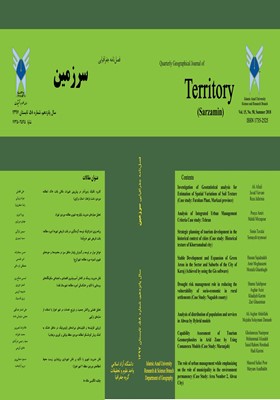برنامه ریزی استراتژیک توسعه گردشگری در بافت تاریخی شهرها (مورد مطالعه: بافت تاریخی شهر خرم آباد)
محورهای موضوعی : جغرافیا و برنامه ریزی گردشگری
پروانه زیویار
1
,
سمیه تیموری
2
*
![]()
1 - گروه جغرافیا، واحد یادگار امام خمینی (ره) شهرری، دانشگاه آزاد اسلامی، تهران، ایران
2 - گروه شهرسازی، واحد یادگار امام خمینی (ره) شهرری، دانشگاه آزاد اسلامی، تهران، ایران
کلید واژه: شهر خرمآباد, برنامهریزی استراتژیک, توسعه گردشگری, بافت تاریخی,
چکیده مقاله :
امروزه گردشگری برجستهترین و کارآمدترین کارکردهای اقتصادی محسوب شده که دستآوردهای اقتصادی،-اجتماعی، سیاسی و فرهنگی بسیاری را برای پیشگامان آن میتواند به ارمغان آورد. این پدیده هماکنون بهعنوان یکی از بنیانهای جهانیسازی و نماد بارز درهم فشردگی فضا زمان شناخته میشود. گردشگری تاریخی که بافت قدیمی و کهن شهرها را در برمیگیرد تأثیر بسزایی در ساختار فضایی و کارکردی یک شهر دارد. لذا هدف پژوهش حاضر برنامهریزی استراتژیک بهمنظور توسعه گردشگری دریافت تاریخی شهر خرمآباد میباشد. روش پژوهش حاضر توصیفی تحلیلی مبتنی بر مطالعات اسنادی و میدانی با استفاده از مدل استراتژیک SWOT ودرگام بعد راهبردهای ارائهشده با استفاده از روش ماتریس کمّی (QSPM) محاسبه میشوند. نتایج پژوهش نشان میدهد راهبرد تهاجمی(SO) (بهرهگیری از حداکثر نقاط قوت و فرصت) با امتیاز 42/3 در اولویت اول و راهبرد رقابتی (ST)(دوری از تهدیدات و استفاده از فرصتها) با امتیاز 63/2 در اولویت دوم بهعنوان مهمترین راهبردهای توسعه بافت تاریخی شهر شناخته شدند
Today, tourism is the most prominent and most efficient economic activity that can bring many economic, social, political, and cultural achievements to its pioneers. This phenomenon is now recognized as one of the foundations of globalization and a hallmark of space-time condensation. Historical tourism, which incorporates the old and ancient texture of cities, has a significant impact on the spatial and functional structure of a city. Therefore, the purpose of this study is to plan a strategic tourism development in the historical city of Khorramabad. The methodology of this research is descriptive - analytical based on documentary and field studies using the SWOT model and then the proposed strategies are calculated using quantitative matrix method (QSPM). The results of the research show that invasive strategy (SO)(utilizing maximum strengths and opportunities) with a score of 3.42 in the first priority and competitive strategy (ST) (avoidance of threats and the use of opportunities) with The 2.63 points were identified as the most important strategies for the development of the historical context of the city in the second priority.
_||_

